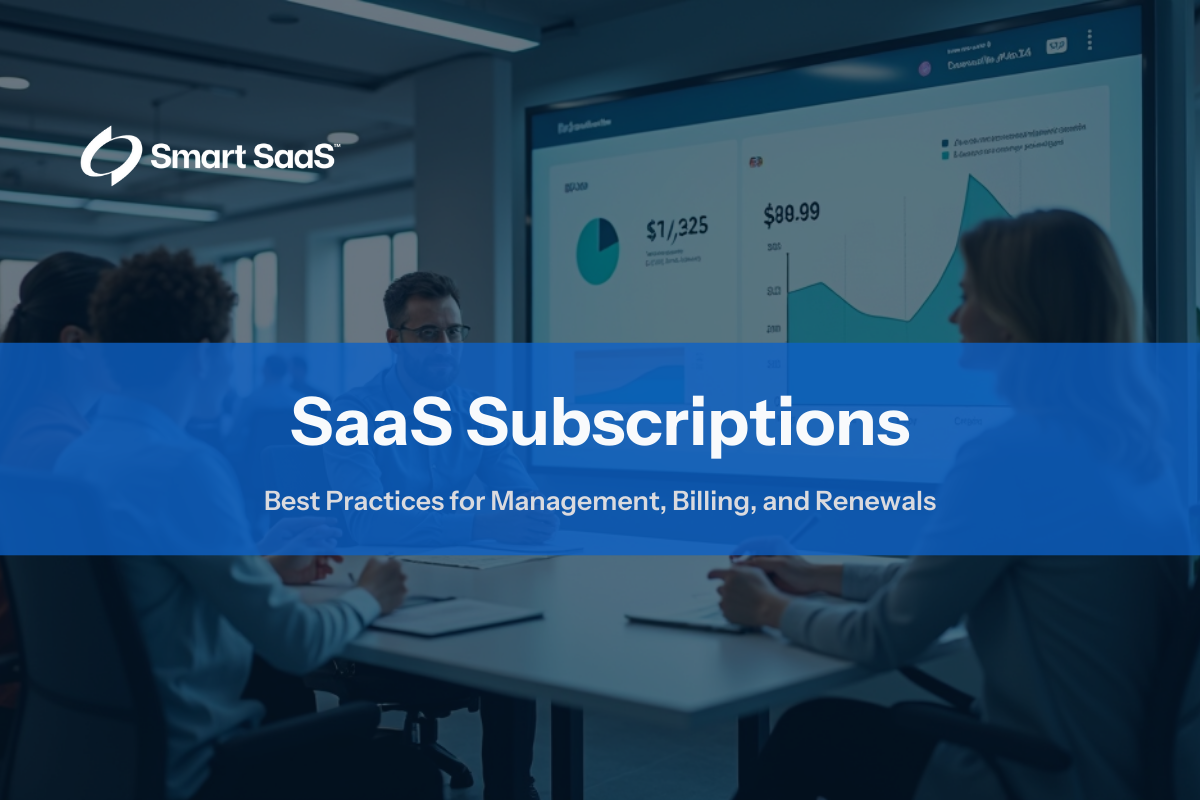

Sunday, April 20, 2025
Josh Cable
Modern businesses run on software as a service. By the most conservative estimates, the average organization uses more than 100 SaaS apps. While some companies are pushing to reign in SaaS sprawl, the global SaaS market – projected to hit $1.1 trillion in value by 2032 – shows no signs of cooling off.
It's easy to see why SaaS has become the go-to delivery model for business software. SaaS promises instant access to powerful tools for streamlining processes and enhancing productivity: Just pick a plan, pay the subscription fee, and log in.
While SaaS has alleviated many traditional IT burdens – hosting and updates, to name a few – its rise also has created its own set of challenges.
Despite its promise of simplicity and flexibility, SaaS can introduce complexities that aren’t readily apparent during the signup process: unpredictable charges, duplicate services, and automatic upgrades, to name a few. Without a structured approach to managing subscriptions and renewals for SaaS, these challenges can blow up budgets and create costly inefficiencies that have a ripple effect throughout the organization.
In this post, you’ll discover some of the pitfalls and fine-print traps that escalate wasteful SaaS spending, and you’ll learn smarter strategies to manage SaaS subscriptions. We’ll share smarter strategies for maximizing the value of your software investments.

When it comes to SaaS subscriptions, not all pricing models are created equal. Choosing the wrong subscription model can snowball into runaway costs, relentless overages, and budget-busting surprises. To make smarter software decisions, it’s important to understand the most common models and their potential impact on your bottom line.
SaaS providers often offer two primary billing options: monthly plans and annual plans.
| Plan | Pros | Cons |
|---|---|---|
| Monthly | Provides flexibility for businesses that need short-term solutions or want to test the platform before committing | Comes with a higher per-month price, adding up to a premium cost over time |
| Annual | Typically offers a discounted rate compared to monthly plans, making them a cost-effective choice for businesses with predictable software requirements | You’re locked in for the duration of the contract, which could leave you stuck with a platform that no longer meets your needs. |
When businesses explore software-as-a-service products, they usually come across several basic types of pricing models. While they might seem innocuous at first, each pricing model can harbor hidden risks that drive up costs over time.
| Pricing Model | How It Works | Benefits | Risks |
|---|---|---|---|
| Per-user pricing | Charges are based on the number of active users. | Easy to understand | Overspending from unused licenses; rising costs as the business grows |
| Usage-based pricing | Businesses pay based on actual consumption (API calls, storage, data transfers, etc.). | Aligns costs with usage | Unpredictable costs; budget overruns triggered by sudden spikes in usage |
| Tiered pricing | Vendors charge progressively higher rates for access to more features, storage, or user seats. | Flexibility and scalability | Confusing tier structures that make it difficult to compare plans; feature paywalls that drive “FOMO” upgrades |
| Flat-rate pricing | Customers pay one price for full access to the software. | Predictable costs | Paying for unused capacity or overcommitting to unnecessary features |
| Token-based pricing | Each interaction with the software deducts a certain number of tokens from the customer’s balance. | Aligns costs with usage | Eye-popping usage spikes triggered by lusty AI consumption; shrinkflation |
| Freemium | Customers get free access to a bare-bones version of the software. | Low-risk entry point for small businesses | Limited functionality that pushes users toward costly upgrades |

In the 1958 sci-fi horror classic “The Blob,” a gelatinous alien creature crashes to earth and grows ever larger as it consumes everything in its path, threatening to engulf an entire town.
In the modern-day business world, SaaS sprawl poses the same kind of slow, silent threat to your budget – quietly expanding and consuming resources before anyone realizes the real danger.
CloudEagle calls SaaS sprawl “a digital pandemic.”
According to BetterCloud, the average number of SaaS apps in an organization skyrocketed by 1,300% from 2015 to 2023, and many IT professionals (55%) confide that they’re struggling to manage SaaS sprawl. Meanwhile, Zylo estimates that the average organization spends $49 million on software as a service each year.
To stop SaaS sprawl before it engulfs your software budget, you need a structured management strategy. In this section, we’ll cover some best practices for managing SaaS subscriptions and maximizing ROI.
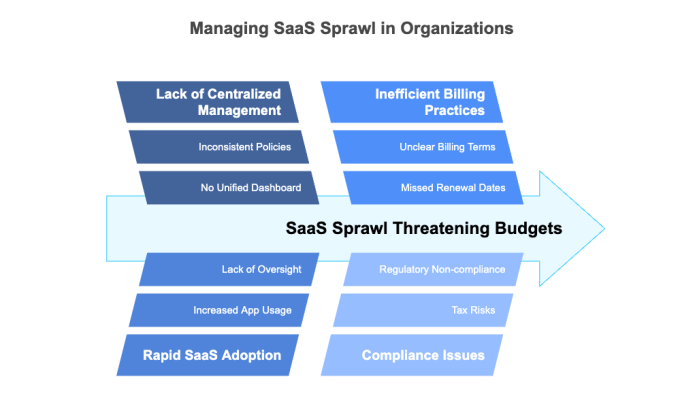
With SaaS platforms just a few clicks away, individual business units and departments can easily purchase their own tools directly from providers – bypassing IT and finance entirely. Although this newfound flexibility has unlocked agility and empowered teams to solve specific problems, it also has moved software spending into the shadows – hence the notion of “shadow IT” – escalating SaaS sprawl.
We’re starting to see a backlash against rogue software spending. In a survey of IT professionals, BetterCloud found that 68% of SaaS apps were managed and supported by IT in 2023, up from 35% the year before.
A centralized dashboard restores financial oversight by consolidating all subscription data in one place. It acts as a single source of truth, giving organizations complete visibility over their SaaS ecosystem. With a centralized system in place, businesses can:

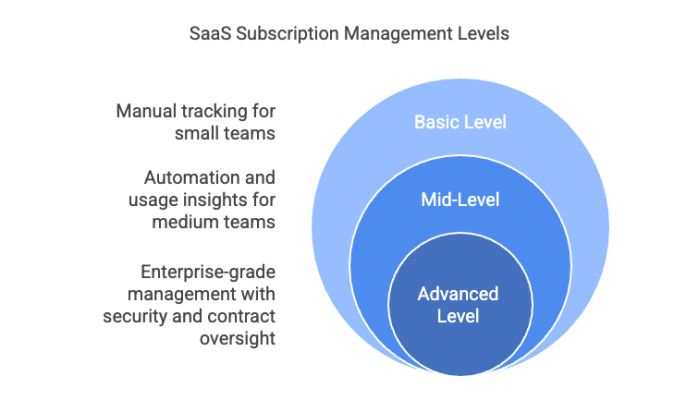
SaaS Sprawl and Shadow IT might seem like nebulous concepts, but they come with real costs. According to BetterCloud, the average company wastes more than $135,000 in unused licenses.
A major contributor to this runaway spending: poorly managed auto-renewals that lock companies into unnecessary contracts and higher pricing tiers.
Without defined renewal policies, companies risk paying for underutilized services, missing critical cancellation windows, and falling victim to “silent upgrades” that push them into premium plans.
Organizations should consider the following best practices:
Costs that are above and beyond the advertised price of a SaaS platform are like a tax on your business.
Download our free e-book, “The SaaS Tax: How Subscription Software Is Draining Your Profits Every Month” and learn how to identify and minimize the hidden SaaS taxes that quietly drain your profits. Get practical tips for reducing SaaS expenses without sacrificing functionality. Download your free copy today!
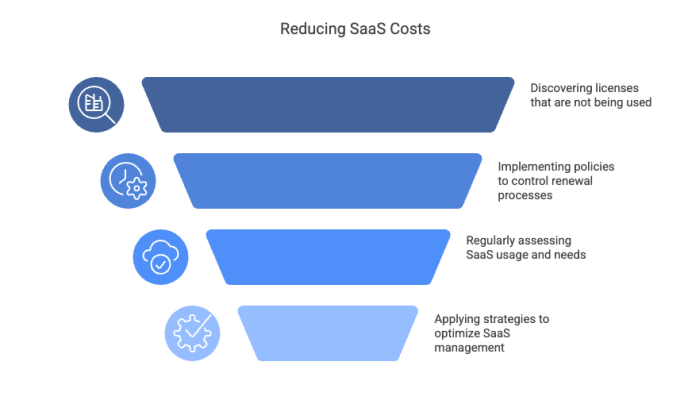

Much like The Blob spreading through every crack and crevice of an unsuspecting town, SaaS sprawl can seep into an organization with an insatiable appetite for budgets. Containing the digital menace requires vigilant oversight of billing, compliance, and ROI.
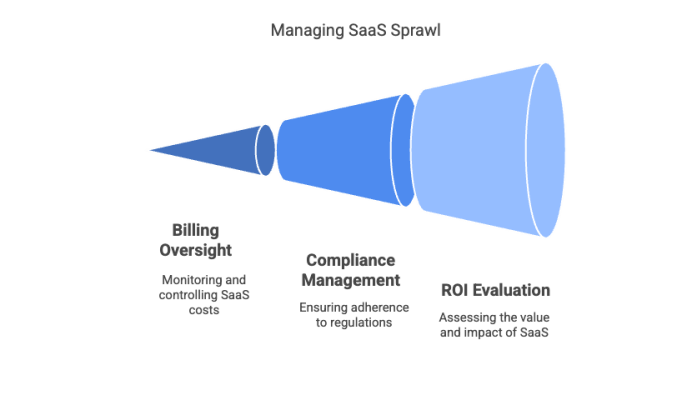
Improving billing visibility and control is essential for managing a growing SaaS stack. The right processes – and platforms – can help your team avoid surprise charges, prevent service disruptions, and keep budgets on track.
Here are a few best practices to streamline SaaS billing:
By putting these controls in place, businesses can simplify payment workflows, reduce billing-related stress, and make smarter, data-driven decisions about software spend.
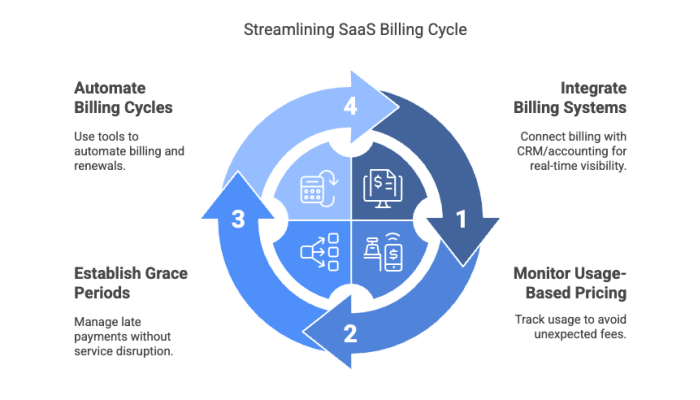
SaaS compliance isn’t just about keeping up with tax obligations. It also involves adhering to industry standards that protect sensitive data and ensure operational integrity.
Tax Compliance
Sales tax on SaaS subscriptions varies by region. For instance, Texas applies sales tax to SaaS subscriptions, while neighboring Oklahoma does not. Many organizations have a legal obligation to collect and remit sales tax in multiple states – even if they don’t have a physical presence there.
To mitigate tax compliance risks:
Regulatory Compliance
Beyond tax considerations, businesses also must comply with data privacy laws such as GDPR or CCPA and industry security standards such as SOC 2 or ISO 27001, depending on where they’re located.
To strengthen regulatory compliance:
By addressing tax-related and regulatory compliance concerns, organizations can safeguard their business from legal pitfalls, maintain customer trust, and avoid costly penalties.
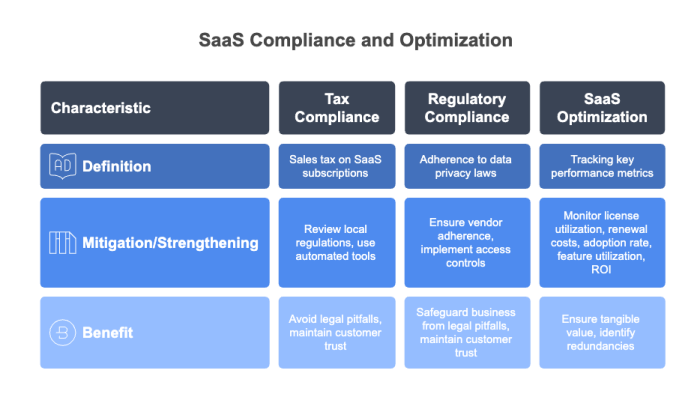
To ensure SaaS subscriptions deliver tangible value, organizations need to track key performance metrics and benchmark usage across departments. Without a structured approach, it’s easy for underperforming tools to slip through the cracks, leeching budgets without delivering meaningful ROI.
Key metrics to monitor include:
In this era of SaaS sprawl, businesses should routinely audit their SaaS stacks to ensure they’re getting the full value from their software investments.
Download our free e-book,“ The SaaS Tax: How Subscription Software Is Draining Your Profits Every Month” to learn how to establish a basic auditing framework for your organization. A strong auditing process can help you identify redundancies and uncover cost-saving opportunities. Download your free e-book today!
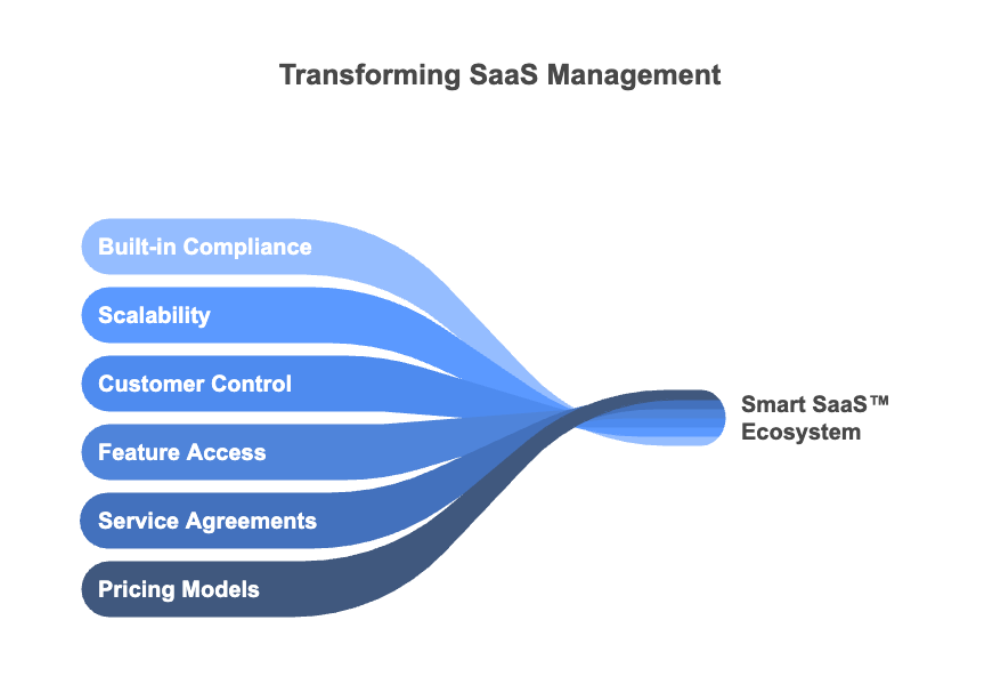

Managing SaaS subscriptions isn’t just about trimming wasteful spending – it’s about transforming how your organization thinks about software.
When done right, a well-structured SaaS management strategy can unlock major cost savings, simplify budgeting, strengthen compliance, and ultimately improve operational efficiency.
That’s where Smart SaaS™ comes in.
Smart SaaS™ reimagines the traditional approach to software as a service – which some call “Dumb SaaS” – with an intelligent, flexible framework that prioritizes transparency, cost efficiency, and real business value.
Much more than a single product or service, Smart SaaS™ is the overarching vision for a SaaS ecosystem in which providers and business customers are partners whose success doesn’t have to be mutually exclusive. It’s a commitment to providing tangible value to businesses without the fine-print traps and profit-boosting tactics that drive wasteful spending.
Here are some of the areas where Smart SaaS™ can help your business put the brakes on runaway SaaS sprawl – and reclaim control of your software strategy:
It’s time to demand more from your software investments. Explore our free library of SaaS resources and start making smarter software decisions TODAY!

SaaS sprawl refers to the uncontrolled growth of software-as-a-service applications within an organization. It often happens when teams and departments independently purchase SaaS tools without centralized oversight or clear policies to manage SaaS subscriptions.
Left unchecked, SaaS sprawl can lead to overlapping functionality, unused licenses, and hidden costs that drive wasteful spending and undermine operational efficiency.
The increasing popularity of SaaS – fueled by low-friction signups and free trials – is one of several factors contributing to SaaS sprawl. The nature of software as a service makes it easy for business users to sign up for SaaS subscriptions without approval from finance or IT. This can lead to overlapping tools, unused licenses, and runaway costs.
Start by inventorying and auditing your SaaS stack to identify unused, duplicate, or redundant tools. Cancel low-value subscriptions and consolidate platforms when possible.
Then, implement a centralized system to track usage, costs, and renewals. Choose pricing models that match your actual needs, and avoid contracts with overage fees, upsells, or hidden costs.
Without structured oversight, organizations risk overspending, exposing sensitive data, and creating operational inefficiencies. SaaS tools often get added piecemeal, without visibility into overall costs or usage.
Effective subscription management brings clarity and control to your software stack, ensuring every tool is secure, well-utilized, and aligned with business goals.
SaaS pricing models vary widely, but the most common are per-user, usage-based, tiered, flat-rate, and freemium. Token-based pricing is an emerging model that’s gaining traction in AI-driven SaaS tools.
Per-user and tiered models are easy to predict but can become expensive over time. Usage-based pricing aligns with consumption, while freemium plans may push users toward paid upgrades for full functionality.
Set calendar reminders or automated alerts 60 to 90 days before renewal deadlines. This gives your team time to evaluate the subscription’s value and cancel if necessary.
Subscription management platforms can centralize this data and reduce risk. Avoid SaaS vendors with auto-renewal clauses, restrictive downgrade policies, or unclear cancellation terms.
